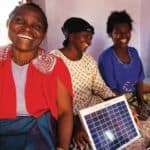Distribute Cash, not COVID-19: Five Ways Policymakers in Sub-Saharan Africa Can Provide Cash Transfers Safely
Two weeks ago, the U.S. passed a $2 trillion stimulus package, part of which will provide cash transfers to a significant portion of the population. India similarly announced it would provide $1.7 trillion rupees (US $22.5 billion) to support its citizens, with cash transfers to vulnerable families making up a share of the funds. To-date, 35 countries have introduced new cash transfer programs in response to COVID-19.
Cash transfers are one of the most effective ways to support people during a crisis. In addition to replacing lost income from the health and economic impacts of COVID-19, they can lessen the financial burden of social distancing and enable families to purchase both health and sanitation supplies. But administering cash transfers in low-income countries, especially to the people most at-risk during the COVID-19 crisis, can raise some big questions for policymakers. How do you distribute cash without spreading the disease? Which people need cash the most? How much support should the government provide? There are a number of steps policymakers in low- middle- income African countries can take to roll out these schemes effectively ahead of, during, and after a large number of COVID-19 cases are detected in their regions.
Step 1: Map the risk
To inform the response to COVID-19 early on, policymakers should preemptively identify the communities that are most in need of health and financial support. Using existing census or household survey data, governments can identify high-risk populations – for example, people with health conditions like asthma or HIV, and dense urban communities. Combined with epidemiological models, policymakers can forecast the spread of the virus and anticipate hot spots – allowing them to prepare to launch cash transfer schemes in these areas more quickly.
Step 2: Shift to e-payments – or bundle cash transfers and test staff
Delivering transfers electronically is generally faster, cheaper and more secure than in-person cash distribution. During a pandemic it’s safer, avoiding any risk of transmitting the virus – which makes this an opportune time for cash transfer programs to shift to e-payments. To fast-track this shift, governments can partner with mobile network operators and build on their mobile money systems.
In places where mobile money or other forms of electronic payments won’t be possible, in-person cash distribution may be the only way to provide households with financial support. In these situations, governments should bundle payments for multiple pay periods into one payment, ideally prior to the point where they’re facing high levels of COVID-19. Implementers should also look to combine bundled payments with financial planning resources or guidance, so families can effectively spread these large payments over several months.
Reducing the risk of virus transmission during in-person cash distribution requires preparing staff to take all possible health precautions. Staff should be screened before traveling to disperse transfers, and they should stay home if they’re demonstrating any symptoms. Hygiene guidelines at pay points (e.g. wearing gloves and masks if possible) will need to be strongly enforced, because even asymptomatic staff can spread the virus.
Step 3: Expand existing cash transfer programs to newly at-risk communities
Many countries have existing cash transfer programs targeted at their most vulnerable citizens –these are often focused on the ultra-poor in rural areas. But amidst this crisis, governments will also need to prioritize distributing cash to those likely to spread the virus (such as urban workers), to make it easier for these individuals to practice social distancing. They should also consider expanding transfers to people at special risk for health impacts, so they can afford self-treatment – as well as to those not currently receiving government support who could be impacted economically.
Systematically identifying these populations can be difficult, but it’s often possible to use existing census data combined with data from social protection or health registries to identify people who will face both high economic and health risks. This data analysis can also help identify how much financial support households need, by examining consumption and income patterns within their communities. In countries with existing cash transfer programs, this infrastructure can be used to enroll and transfer cash to new households once they have been targeted.
Step 4: Use cash distribution points to share health messaging
In most crises, supplies and information are distributed through key hubs where community health workers or community leaders connect. Governments have an opportunity to streamline efforts across ministries, non-profits and multilaterals, to create central distribution points for cash transfers, supplies and updated health information. Information about prevention and treatment for COVID-19 or other valuable health communications materials can be shared with cash transfer officers to be distributed across communities.
Step 5: Use phone surveys to monitor the pandemic’s spread and economic impact
To track the spread of COVID-19 and its economic repercussions, phone surveys of cash transfer recipients can be conducted (using recipient phone numbers from existing program registries). Information from these surveys can also be extremely valuable in creating and disseminating effective communications campaigns and allocating health resources. The surveys can provide data and insights into how communities are doing economically, and what additional support or supplies they need.
These are just a few ways that policymakers can leverage data to strengthen their COVID-19 response efforts and effectively execute cash transfer programs. These recommendations are broad, but they can and should be contextualized to fit the needs of each country and community. IDinsight’s full policy brief on implementing cash transfers during COVID-19 can be viewed here, and more information on IDinsight’s response efforts can be found here. Please get in touch if you have ideas, or are interested in working with us to localize and implement these recommendations.
Martin Gould is Associate Director and Nate Vernon is a Senior Associate at IDinsight.
Main photo courtesy of Kate Holt / AusAID.
Homepage photo courtesy of vjkombajn.
- Categories
- Coronavirus, Finance



